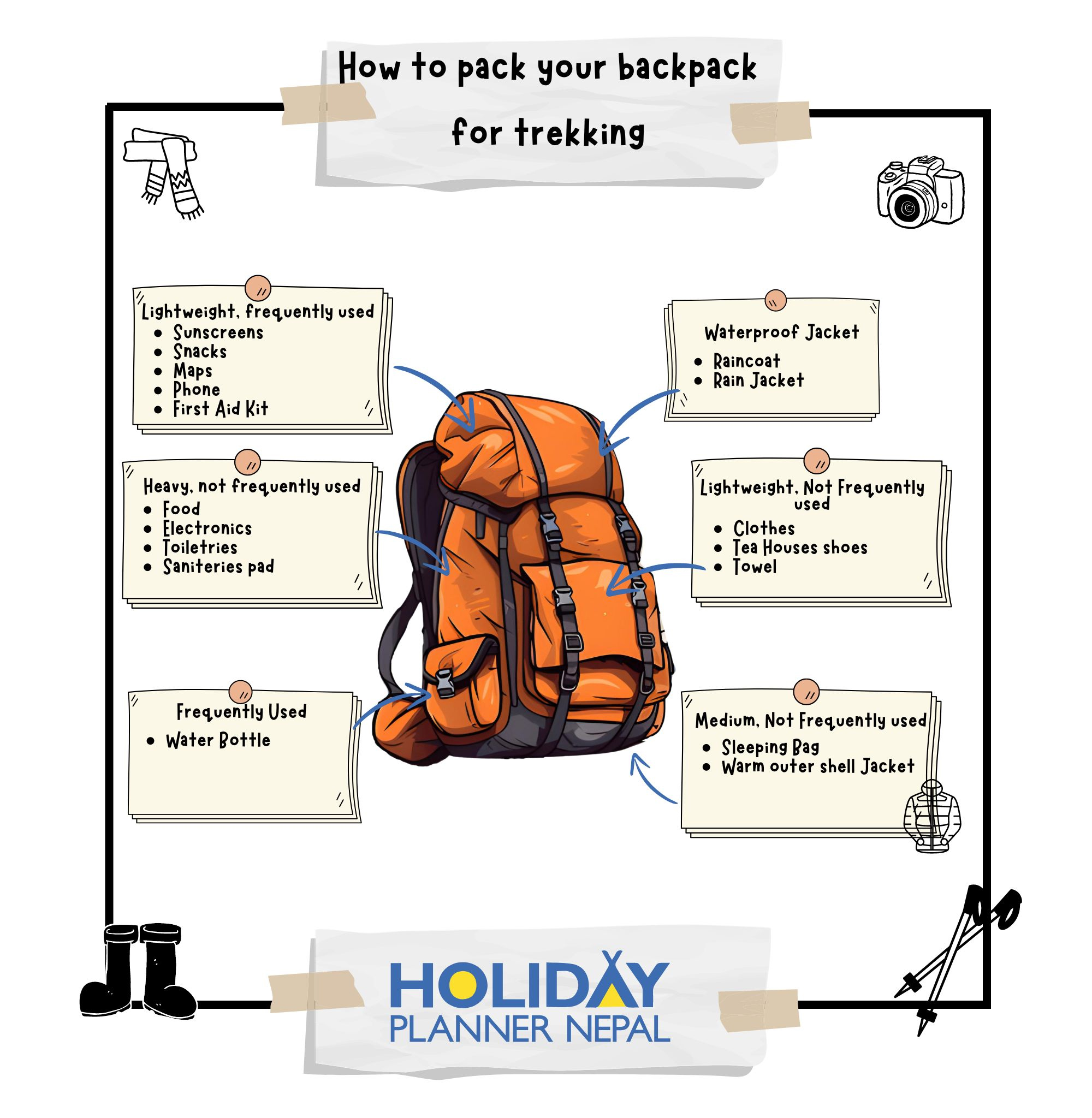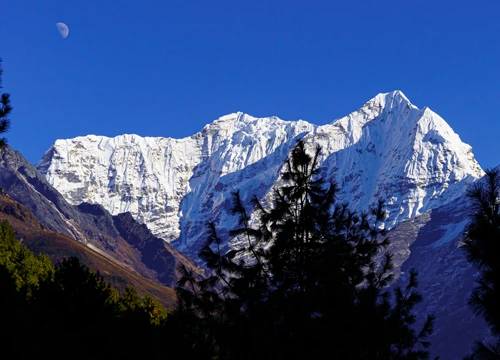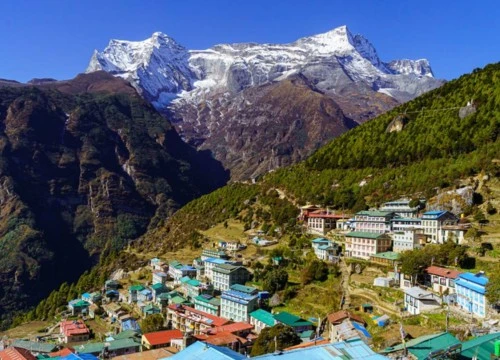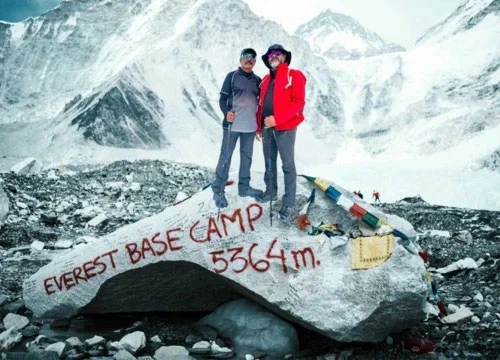Trek Introduction: Everest Base Camp Trekking – A Journey to the Roof of the World
"Imagine trekking in the shadow of the world's highest peak, Sherpa Land, and having the best Mount Everest view from Kalapatthar and Everest Base Camp. Everest Base Camp Trekking is one of many people's ambitions to see Mount Everest, the tallest peak on earth, which soars over the blue skyline at 8,848 m (29,028 ft).
This is one of the most intriguing regions for all types of adventure, located in the high and picturesque Khumbu region, in the shadow of Mount Everest and other high peaks that surround you on your incredible Everest Base Camp Trekking.
As our trip progresses each day, we'll be traveling towards the famed and magnificent Tengboche Monastery, a delightful destination with views of mountains inside a green forest surrounding the area where Mani-Rimdu, a spectacular and colorful festival held in October, takes place.
As we leave the lush green flora and tree lines behind and enter the barren and desert region within the arctic zone of ice and glaciers at Everest Region, we are met with the breathtaking beauty of massive peaks and the legendary Khumbu Ice Falls and glaciers.
After spending time beneath the towering South Face of Everest, return to Lukla with a hike to Kalapatthar, the highest point of the expedition at 5,545 m, which affords a breathtaking view of Mount Everest within a stone's throw. Finally, after a once-in-a-lifetime trip to Everest Base Camp, our wonderful scenic and cultural walks conclude in Lukla for an exciting journey back to the hustle and bustle of Kathmandu.
Why Choose Everest Base Camp Trek in Nepal?
However, the Everest Base Camp Trek is a challenging and rewarding journey that takes you through beautiful and varied landscapes and offers the opportunity to experience the culture and way of life of the local Sherpa people. Many people who have completed the trek describe it as a life-changing experience and a tremendous personal accomplishment. To challenge oneself: The Trek to Everest Base Camp is a physically and mentally challenging journey that offers the opportunity to push oneself out of one's comfort zone and test one's limits. To experience the beauty of the mountains.
The Everest Region is home to some of the most breathtaking mountain scenery in the world. The trek offers the chance to experience this beauty up close. To immerse oneself in the local culture: The Everest Region is home to the Sherpa people, who have a rich culture and way of life. The trek offers the opportunity to learn about their traditions and way of life and to experience their hospitality and kindness. To achieve a personal accomplishment: Completing the trek to Everest Base Camp is a great personal accomplishment and a source of pride that many people describe as a life-changing experience to escape the hustle and bustle of daily life. The trek offers the chance to escape the distractions and stresses of everyday life and reconnect with nature and oneself.
How does the Everest base camp trekking start and end?
Everest Base Camp trek begins with a magnificent flight to Lukla's Sherpa town and its unusual little airfield. Then, our walk follows the Dudh-Koshi River upstream via the Sherpa agricultural communities of Phakding and Monjo to enter Sagarmatha National Park.
We spent a day extra in Dingboche for acclimatization before pushing ourselves towards the 5000-meter altitude. From Dingboche, we got to Lobuche, where we stayed the night and went the next day towards Everest Base Camp. After reaching Everest Base Camp and spending some time there, we come down towards Gorakshep, where we spend the night. The next day, we head towards Pheriche or Pangboche, depending upon the client's condition, follow the trail towards Namche for the tenth day of our trip, and head towards Lukla on the final day to celebrate our achievement and conduct a party.
We fly back to Kathmandu on the 13th day after completing Everest Base Camp Trek.
Note: The trek to the Everest Base Camp usually starts in the village of Lukla, a short flight from Kathmandu. From Lukla, it takes about 11 days to reach the base camp and get back to Lukla, depending on the route and the pace of the trekker. The trek to the base camp is a popular adventure for people who enjoy hiking and experiencing different cultures. It is an achievable goal for people with moderate fitness levels.
Everest Base Camp Trekking - 14 Days Altitude and Distance Coverage
Day | Activity | Altitude (m/ft) | Distance (km/miles) | Duration (hours) | Elevation Gain/Loss |
01 | Arrival in Kathmandu and transfer to the hotel. Evening briefing and welcome dinner. | 1,350 m / 4,429 ft | - | ~30 min drive | - |
02 | Fly to Lukla and trek to Phakding. | 2,860 m / 9,383 ft 2,640 m / 8,661 ft | ~7 km / 4.3 miles | ~4 hrs walk | -190 m / -623 ft |
03 | Trek to Namche Bazaar. |
| ~11 km / 6.8 miles | ~6 hrs walk | +800 m / +2,625 ft |
04 | Acclimatization day at Namche Bazaar with local excursions. | 3,440 m / 11,286 ft | ~3-5 km / 2-3 miles (hike) | Flexible | ~+300 m / +984 ft (optional) |
05 | Trek to Tengboche Monastery. | 3,867 m / 12,687 ft | ~9 km / 5.6 miles | ~5 hrs walk | +427 m / +1,401 ft |
06 | Trek to Dingboche. | 4,260 m / 13,976 ft | ~9 km / 5.6 miles | ~5 hrs walk | +393 m / +1,289 ft |
07 | Rest and acclimatization day at Dingboche with optional hikes to nearby viewpoints. | 4,260 m / 13,976 ft | ~4-6 km / 2.5-3.7 miles (hike) | ~3-4 hrs (optional) | ~+200 m / +656 ft (optional) |
08 | Trek to Lobuche. | 4,930 m / 16,174 ft | ~7 km / 4.3 miles | ~5 hrs walk | +670 m / +2,198 ft |
09 | Trek to Everest Base Camp and return to Gorakshep. | 5,364 m / 17,598 ft | ~12 km / 7.5 miles | ~6 hrs walk | +434 m / +1,424 ft (to EBC), -434 m / -1,424 ft (back to Gorakshep) |
10 | Hike to Kalapathar and trek to Pangboche via Pheriche. | 5,545 m / 18,192 ft | ~15 km / 9.3 miles | ~6 hrs walk | -1,645 m / -5,397 ft |
11 | Trek to Namche Bazaar. | 3,440 m / 11,286 ft | ~11 km / 6.8 miles | ~6 hrs walk | -460 m / -1,509 ft |
12 | Trek to Lukla. | 2,860 m / 9,383 ft | ~18 km / 11.2 miles | ~4 hrs walk | -610 m / -2,001 ft |
13 | Fly back to Kathmandu and transfer to the hotel. | 1,350 m / 4,430 ft | - | ~35 min flight | -1,480 m / -4,856 ft |
14 | Final international departure from Nepal. | 1,350 m / 4,430 ft | - | ~30 min drive | - |
How fit should you be for trekking to Everest base camp?
The Everest Base Camp Trek is a physically demanding journey that requires good physical fitness. The trek involves walking for several hours daily over uneven terrain at high altitudes. It can be challenging even for experienced hikers. Being in good physical shape and having a solid cardiovascular system before attempting the trek is essential.
To prepare for the trek, engaging in regular physical activity such as hiking, running, or cycling is required to build up your stamina and strength while carrying a backpack. It is also a good idea to acclimatize to high altitudes by spending some time at elevations above 2500 meters (8200 feet) before embarking on the trek. Acclamation can help your body adjust to the lower oxygen levels at high altitudes and reduce the risk of altitude sickness.
It is also essential to be mentally prepared for the challenges of the trek, as it can be physically and mentally demanding. It is a good idea to have a positive and determined mindset and to be prepared to push yourself out of your comfort zone. The key to preparing for the Everest Base Camp Trek is to be physically and mentally fit and well-prepared with the necessary gear and support.
The Everest Base Camp Trek is an excellent choice for those in good physical shape who enjoy being outdoors and experiencing new cultures. It is a challenging journey that requires a certain level of physical fitness and mental determination. Still, the sense of accomplishment and personal growth that can come from completing the trek make it an enriching experience. If you are considering the trek, you must be well prepared and ensure you have the necessary gear and support. Many experienced tour operators and guides can help make your trip safe and enjoyable.
What is the best season and time for Everest base camp trek?
The Himalayas have two hiking seasons pre-monsoon (February, March, April, and May) and post-monsoon (June, July, and August; late September, October, November, and December). An excellent view of the entire Himalayan range from the Everest Region may be seen. Furthermore, this is a perfect time to visit Nepal since numerous significant cultural events also take place, including Nepal's big festival, Dashain. The temperature range is ideal at that time, ranging from 10 to 25 degrees Celsius. However, the last week of December was colder than usual.
It is important to note that the weather in the mountains can be unpredictable, and it is possible to experience rain or snow at any time of year. Being well-prepared with the necessary gear and clothing and flexible travel plans is a good idea.
The trek to Everest Base Camp is usually possible from September to November and March to May. These are the autumn and spring seasons in the region and offer the best combination of good weather and clear mountain views.
The autumn (September to November) is a popular time to visit, as the weather is usually clear and dry and the air is cool and crisp. This is a good time for those who want to avoid the crowds and enjoy the quiet and peacefulness of the mountains.
The Spring Season (March to May) is also an excellent time to visit, as the weather is mild and the mountain views are clear. Spring is a popular time for those who want to see the mountain in all its glory, as the snow-covered peaks are spectacular. However, the spring season is also the busiest time for tourism in the region, so the trails and lodges may be more crowded.
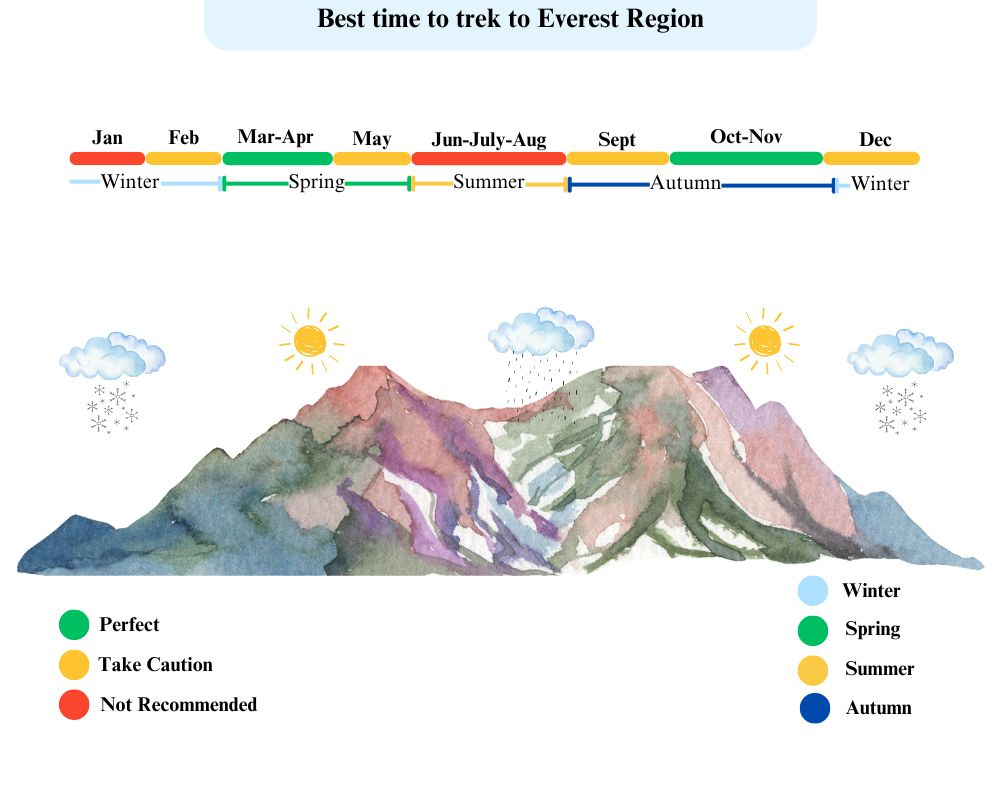
Local culture and traditions around Everest region
In Everest Region, sherpas make up the bulk of the population. Buddhists make up the vast majority of Sherpas. The Lhosar festival is the primary event in the Everest Region. Gyalpo Lhosar is the Sherpa name widely celebrated in the Everest Region. On the English calendar, it is in February or March. Sukuti and Chhyang (Tibetan beer) dumpling feasts are served to mark the event. The dwellings are precisely cleaned, with particular attention given to the kitchen, where the family eats. Every Sherpa community has a monastery, some over 500 years old, such as the "Monasteries of Thame and Pangboche villages. However, the famed Tengboche Monastery was even older. It was destroyed by a massive fire in 1991 and rebuilt to its original form again.
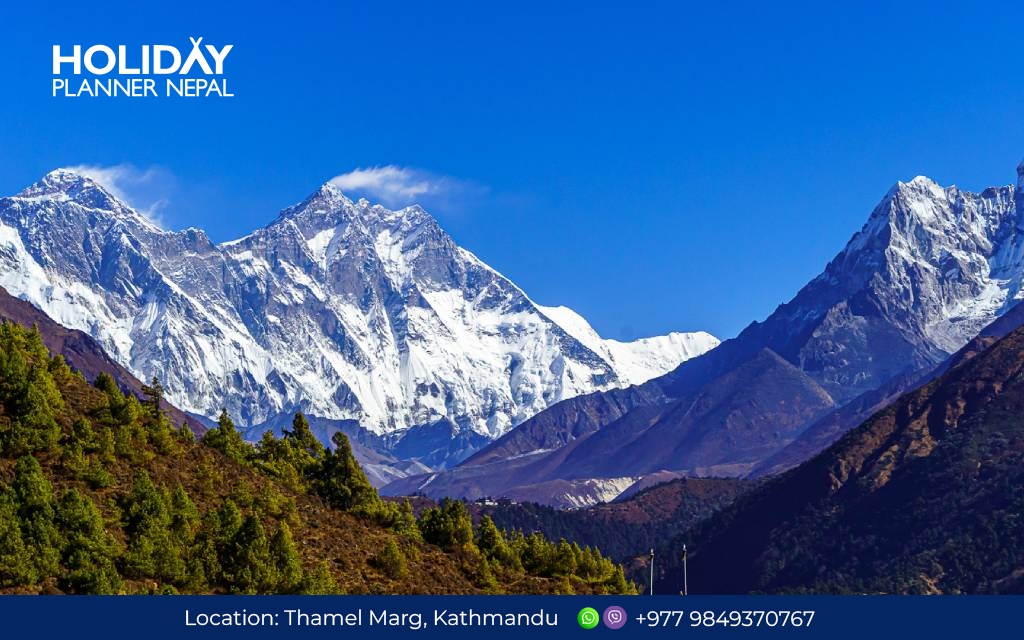
How is the accommodation facility at Everest Base Camp?
As a developing nation, as we travel to the rural Himalayan Region, the vegetation infrastructure's availability of facilities and services decreases, which is one of the main reasons we sometimes have to sacrifice for the best services. However, because this is a tourist route, most amenities remain accessible. For example, there is 24-hour power, laundry services (due to a lack of warmth and sunlight), Internet, fruits, hot showers, toilet commodes, room quality, and availability (standard-quality rooms are found that are designed to meet the basic requirements). On the other hand, Holiday Tours Nepal makes every effort to provide the best services and amenities available.
We have the option of providing rooms with electric blankets and attached bathrooms at an additional cost of $400 per person. These types of lodges are not luxurious lodges, but they are comfortable lodges compared to normal and basic lodges and are warm and comfortable. Places like Phakding, Namche, Tengboche, Debouche, and Dingboche offer these facilities. For the last two days at Gorakshep and Lobuche, attached bathrooms have not been available, but electric blankets are available, which work through solar panels. In case the blankets are not working, we provide hot water bags to all the clients and trekkers.
Why is acclamation required for Everest Base Camp trek?
Adapting to the surroundings, including temperature, climate, traditions, cultures, and cuisine, is one of the most important aspects of completing and enjoying the journey. When planning our itineraries, we always need to remember that we should not climb more than 800 meters a day, and if we climb more than that, we need to rest for acclamation. Climbing more than 1000 meters causes altitude sickness and respiratory problems. On the other hand, slowing down and stopping along the way assists our bodies in adjusting to changes in temperature, weather, and climate. We sometimes go on a trek to walk and hire a guide, but that doesn't mean they will lead and make your trip successful. You have to be mentally prepared and well-acclimatized in order to make your trip successful.
Foods and beverages that cause physiological and emotional stress, such as diarrhea, constipation, headaches, anger problems, a sensation of maltreatment, and a lack of services, must be avoided occasionally.
Before heading to Everest Base Camp, it is essential to inquire about available accommodations. Visitors should always note which foods and beverages they are allergic to or do not consume, as this will assist in formulating a plan for food and drink.
Inform Holiday Tours Nepal about any allergies or medical conditions before booking an Everest Base Camp trip in Nepal.
Permits cost for Everest base camp trekking
Nationality | Khumbu municipality permit cost | Sagarmatha national park permit cost | Apply for permits now |
Indian citizens | Rs 3000 | Rs 2000 | Apply for permits |
Foreign citizens | Rs 3000 | Rs 3000 | Apply for permits |
Nepali citizens | Rs 100 | Rs 100 | Apply for permits |
Is travel insurance required for Everest Base Camp Trekking?
Holiday Tour Nepal strongly advises and recommends that all our guests obtain travel and medical insurance in case of unforeseen events during their Himalayan holiday. Travel and medical insurance must be completed and acquired before traveling to Himalayan areas. Our guests must have travel and medical insurance before going on any trip or trek with Holiday Tour Nepal. It should include enough coverage for tours and excursions, such as personal injury, death, medical expenses, and repatriation costs for any transportation used during emergency evacuations, such as helicopter rescue, air ambulance, or appropriate luggage cover.
What is the cost for helicopter rescue in Everest region?
There are two types of policies. The first one is in which the trekkers pay first and get paid back by the insurance company, and the other is in which the insurance company pays up all the amount upfront.
For rescue, the helicopter charges $5500 for chartering it from Everest Region to Kathmandu. Then, from the airport, the trekkers are taken to the hospital in an ambulance, and the doctors and nurses take over from there. The patient is kept in the hospital for observation and treatment and is discharged when the hospital gives discharge clearance.
Can we get altitude sickness during Everest Base Camp Trek?
Anyone can get mountain sickness. The low air pressure at high altitudes makes breathing difficult due to the lack of oxygen in the atmosphere. Above 3300 m, it is more prevalent (10,000 ft). The following are the indications and symptoms:
- Dizziness or headache
- Nausea and vomiting
- Fatigue and tiredness (tired but unable to sleep),
- Appetite loss
- Stress and anger,
To avoid Acute Mountain Sickness (AMS), dress appropriately for the weather, drink enough water, eat properly, and move slowly.
Requesting rest or heading back down to the lowest altitude is best if you're not feeling well. Maintain moisture and follow the tour leader's directions and mountain sickness advice. If minor problems emerge during a walk, our guides are well-trained in first aid. Travelers and trekkers should have their own insurance before coming to Nepal in case of an emergency. All of our personnel are insured. If an emergency helicopter evacuation is necessary, we may arrange a helicopter rescue, which your insurance may reimburse.
How is the toilet and shower facility at Everest Base Camp?
Toilets are available in two types: Western and Asian styles (squat toilets). The bathrooms are on the same floor or attached to the room. Since you are in the mountains and the water can be frozen, having your own toilet paper is necessary. Toilet paper is not to be flushed. Instead, use the trash can inside the restroom.
Every guest house includes a hot shower, which might be a geyser shower or a bucket of hot water. Please limit the use of hot water while showering unless it is solar-heated for environmental reasons. If the water is frozen, ask your guide for warm water..
How is the internet and electricity facility at Everest Base Camp?
As a developing country, energy infrastructure is not available in certain places, and even when it is, electrical shortages can occur due to natural or human causes. Carrying a power bank is recommended for charging the batteries of mobile phones, cameras, flashlights, and other gadgets.
Guest houses charge extra to recharge the battery. Generators, solar panels, and even private hydropower are used to meet the demand for electricity.
Getting connected to the Internet on Everest requires a specific amount of payment, which varies from place to place. Mobile data is not available as we cross Pangboche.
Everest base camp outline itinerary: 14 Days.
- Day 1: Arrival in Kathmandu at 1,350 meters and transportation to the hotel.
- Day 2: Fly to Lukla (2,830 m) and trek to Phakding (2,640 m) in four hours.
- Day 3: 6-hour trek to Namche Bazaar (3,440 m).
- Day 4: Acclimatization day and local trip at Namche Bazaar.
- Day 5: 5-hour trek to Thyangboche Monastery (3,867 m).
- Day 6: 5-hour trek to Dingboche (4,260 m).
- Day 7: Acclimatization and a touring day at Dingboche.
- Day 8: 5-hour trek to Lobuche (4,930 m).
- Day 9: Trek to Everest Base Camp (5364 m) and back to Gorakshep (5180 m) in 6 hours.
- Day 10: Hike to Kalapathar (5,545 m) and then walk to Pangboche (3,900 m) through Pheriche (6 hours).
- Day 11: Trek to Namche Bazaar - 6 hours of walking.
- Day 12: The trek to Lukla takes four hours.
- Day 13: Fly back to Kathmandu from Lukla.
- Day 14: Nepal's final international departure.

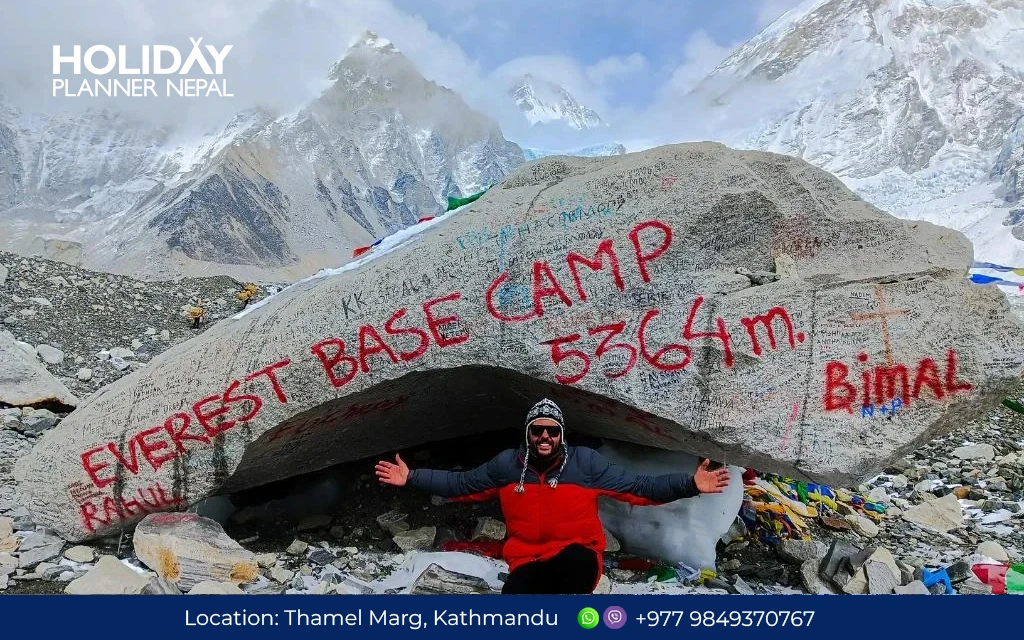
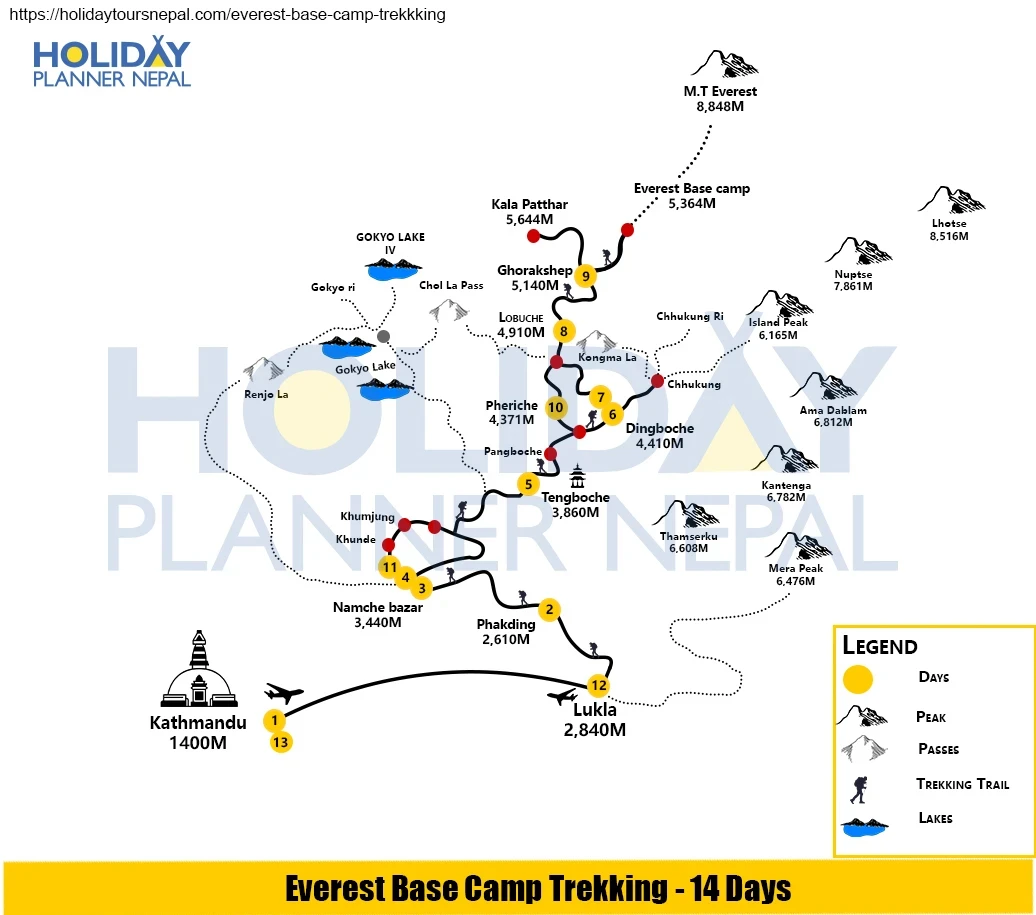
 General
General Upper Body
Upper Body Torso
Torso Lower Body
Lower Body Hands
Hands Feet
Feet Undergarments and Inner Wears
Undergarments and Inner Wears First Aid Kits and MedicationsSunscreen SPF- 50+
First Aid Kits and MedicationsSunscreen SPF- 50+ Other Essentials
Other Essentials